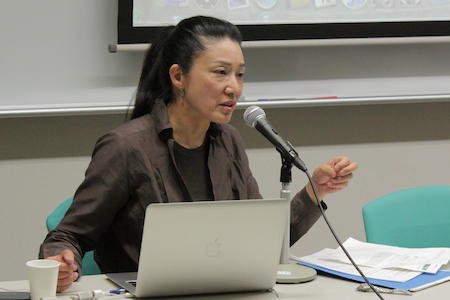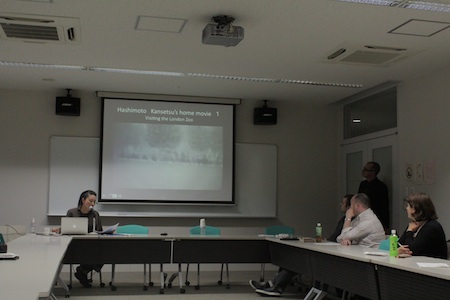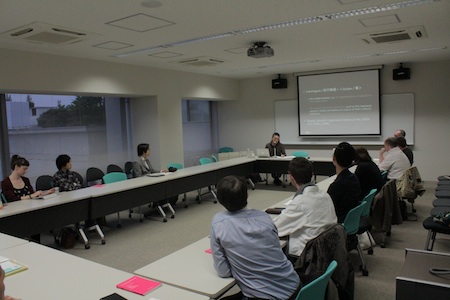[Report] Lecture by Prof. Mitsuyo Wada-Marciano "2 + 1 Travelogues: Memories from the Empire of Japan"
On April 19, Mitsuyo Wada-Marciano (Carleton University) gave a presentation entitled "2 + 1 Travelogues: Memories from the Empire of Japan".
Prof. Wada-Marciano's research covers film history, Japanese cinema, its relationship to Japanese modernity, the impact of digital technology on cinema, and East Asian cinema in global culture.

In this presentation, Wada-Marciano analyzes rare home movies from the 1930s, with focus on creations by two members of the Japanese cultural establishment: Nose Katsuo, the editor of the newspaper Doyobi, and the nihonga painter Hashimoto Kansetsu. These home movies offer personal views of the historical moment in which the Japanese Empire had expanded its territory, enabling citizens to cross national borders, explore, and observe the "new" territories. They filmed these experiences, leaving them behind as personal travelogues.
With the defeat of Japan in 1945, the space of the nation was rolled back to the Japanese archipelago proper, and the Empire became a past memory. For political and ideological reasons, the postwar Japanese needed to detach themselves from the cultural moment of the Empire, consigning it squarely to the past. At an individual level, this meant suppressing personal memories, especially those embodied in images of the imperial past. While it is thus apt for the postwar generations to view the 1930s as a time of political darkness, economic chaos, and cultural gloom, Wada-Marciano draws our attention to the images captured in the home movies of the period, which prove unexpectedly bright with hope and humor.
To elucidate this gap between the images in the footage of these home movies and the historical preconceptions of the period, Wada-Marciano proposes a re-reading of the philosopher Watsuji Tetsurô’s Fûdo (Climate and Culture), both as an interpretive matrix for understanding these films, the forms of relationality they imply, but also to approach the text of Fûdo as itself a form of travelogue. In this fashion, we may be able to find a new perspective on these travelogues, viewed from a personal rather than national angle, and consider them as sites which bear the traces of a broader negotiation between the forces of modernization and Japanese cultural practices.

Where the global power dynamics of modernization (i.e., capitalism and imperialism) are animated by a drive to sustain and expand nations, the vernacular dynamics they conflict with could be said to embody the Japanese people's bodily sensation of culture, or their cultural practices. In the 1930s, one important manifestation of these global dynamics was the circulation of media technology. Significantly, this was the period in which home movie cameras and projectors appeared on international markets. These can be located in processes of industrial modernization. Moreover, the consumers of these new cameras were often members of the monied classes who were able to travel extensively, creating personal travelogues in the form of home movies.
Wada-Marciano further draws our attention to the curious fact that public zoos appear repeatedly in the home movies of this period. While Hashimoto Kansetsu filmed zoos in both Japan and Europe on a number of occasions, they also appear in home movies from Taiwan, as well as the well-known film-in-film sequence from Ozu Yasujirô's I Was Born But… (1932). It goes without saying that zoos may be understood as an entertainment form, but for Hashimoto the painter, they also seem to serve a function as a space for observation. As a specialist of nihonga, Hashimoto is known for his depictions of animals in a new realist style. The development of this style may be linked to his use of the film camera as an observational tool in the space of the zoo. Looking at this historical moment, then, Wada-Marciano proposes that we may thus read the subjects of these home movies as both a view on and an incarnation of a modern, international space.

With respect to the vernacular dynamics of the 1930s, Wada-Marciano examines some of the cultural practices involving home movies, through which the Japanese people found themselves and constituted their own identity. Here, the Watsujian notion of fûdo may be applied to understand the vernacular dimensions of cultural practice. Among the various ways that Watsuji defined fûdo (e.g., as the environments of the monsoon, desert, and grassland climes), he proposes an intersubjective experience of community or relationality. While Watsuji's argument has been traditionally criticized as an early instance or exemplar of nihonjinron, there have been more recent readings (e.g., by Augustin Berque) which place it into a more critical relationship with the forces of globalization. In this spirit, Watsuji's argument may be useful for understanding the vernacular dynamics that find expression in the home movies of this period.
Wada-Marciano proposes that we might read the film travelogues of Nose and Hashimoto as themselves forms of inquiry running parallel to Watsuji's exploration of fûdo. That is, we may approach both as reflections on colonial spatiality in the 1930s. What, then, is the role of the film camera in representing or mapping these spaces? What, moreover, would it mean to read these films in Watsujian terms, that is, in face of the fact that they are representations of colonized spaces?






